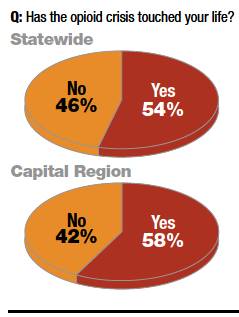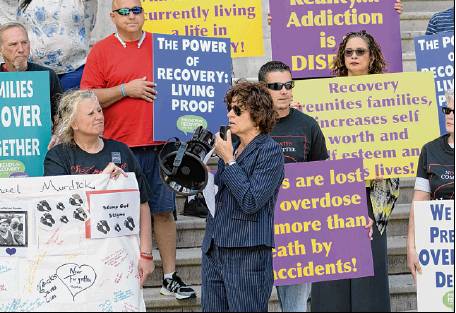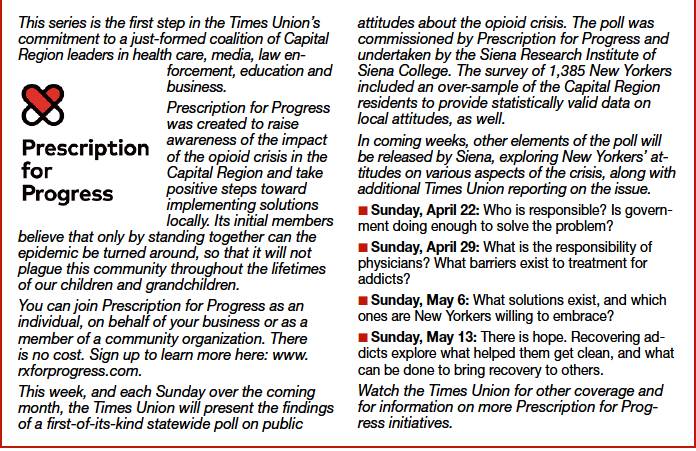Survey shows depth of crisis
Siena’s research details a “shocking” reach, plus New Yorkers’ opinions
By Bethany Bump
One in four New Yorkers knows someone who has died after overdosing on opioids and more than half have been directly touched by opioid abuse, according to a first-of-its-kind poll released Sunday.
The survey by Siena College Research Institute is the first comprehensive measure of the epidemic’s reach in New York — quantifying its impact beyond officially reported deaths and hospitalizations and gauging the opinions of nearly 1,400 New Yorkers about who is responsible for the crisis, how it’s been handled to date and what more ought to be done. Results will be released in stages over the next four weeks.
“Often we’re asked what finding is surprising in a poll,” said Don Levy, director of the institute. “That one in four of us know someone that this epidemic has taken and nearly six in 10 of us are currently touched by it is shocking.”
Shocking, yes. Surprising? Not to those who have been working the front lines of the crisis for years now. What is surprising, they say, is the number of people now willing to reveal their own connection to such a polarizing addiction.
“The fact that this survey was specific to opioids, and not all the other more accepted manifestations of addiction like alcohol, is pretty significant,” said Stephanie Campbell, executive director of Friends of Recovery-New York. “That one out of two people have been touched by opioid abuse — that’s a big number.”
Specifically, 54 percent of New Yorkers say they have been directly touched by opioid abuse, meaning that either they or a family member, friend or colleague has abused prescription painkillers, heroin or other opioids, or someone they know has told them about someone in their family who has abused them. That number is higher in the Capital Region at 58 percent.
The survey, commissioned by a new Capital Region-based coalition — Prescription for Progress: United Against Opioid Addiction — intentionally oversampled in the region. Results will be used to inform the work of the coalition, which seeks to bring health care, business, government and frontline workers together to fight the epidemic locally.
Sixteen percent of survey-takers said that they or an immediate family member have abused opioids. One in four said that a friend or extended family member has abused opioids. Another one in four said someone they know has shared that someone in their family abuses opioids. Fourteen percent know someone through work who has abused opioids.
Most New Yorkers — 80 percent — agree with experts who say the U.S. is in the middle of an epidemic. And few believe it’s slowing down — 83 percent said they believe it’s getting worse, while just 4 percent said they believe it has improved. Asked about the area where they live, 41 percent said it’s a “very serious” problem in their area while another 41 percent said it was a “somewhat serious” problem.
This was sobering but encouraging news to advocates, who believe state government has been slow-footed in its response to the crisis. While more responsive than other parts of the country, they say, New York is still not funding prevention, treatment and recovery efforts at levels needed to slow ever-rising hospitalizations and deaths.
Deaths from heroin and other opioids increased more than 50 percent in New York from 2,300 in 2014 to 3,638 in 2016, according to the federal Centers for Disease Control and Prevention. And those statistics are likely deflated, experts say, since no uniform system exists for tracking and reporting overdoses, and discerning cause of death can be difficult when a variety of drugs are found in people’s systems.
“How bad do things have to get in order for state government to actually pay attention to this issue?” said John Coppola, executive director of the New York Association of Alcoholism and Substance Abuse Providers. “It’s going to take outrage — outrage from communities —pure and simple.”
That so many people outside the fields of medicine and addiction now recognize the crisis as an epidemic that’s getting worse should signal to government and policymakers that the status quo is no longer acceptable, said Campbell.
“This is everyday people saying, things are getting worse,” she said. “That’s powerful.”
• bbump@timesunion.com • 518-454-5387 • @bethanybump
“How bad do things have to get in order for state government to actually pay attention to this issue? It’s going to take outrage — outrage from communities — pure and simple.”
John Coppola, executive director of the New York Association of Alcoholism and Substance Abuse Providers


